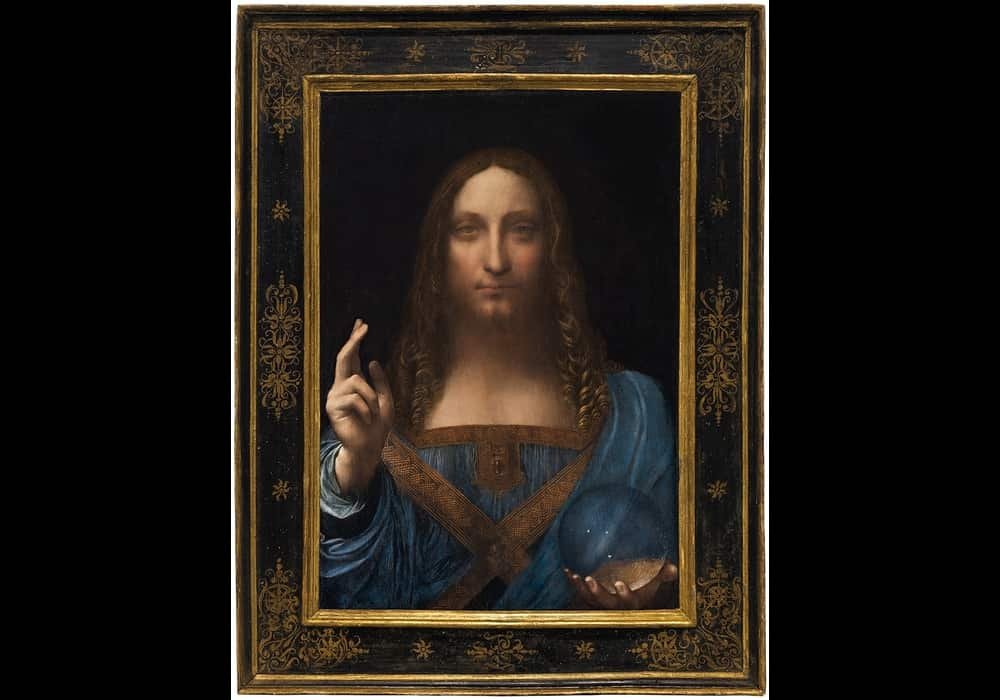The Most Expensive Painting
Salvator Mundi by Leonardo da Vinci holds the esteemed title of the most expensive painting in the world. Translated from Latin, Salvator Mundi means “savior of the world.” But what makes this masterpiece fetch such an exorbitant price? Dive deeper into the fascinating story behind this iconic artwork below!
Salvator Mundi by Leonardo da Vinci, the most expensive painting in the world.
Salvator Mundi (Latin for ”Savior of the World”).
This painting by Leonardo da Vinci of Christ dates from 1500. This oil painting on walnut wood is perhaps less famous than The Mona Lisa, but it bears the characteristic style of the most famous Italian painter of the Renaissance. Disappeared for many years, the painting reappeared in 2005 before becoming the most expensive canvas in the world at its auction.
Read also: Most Famous Paintings in the World
In fact, on November 5, 2017, during a sale at Christie’s New York, the painting was purchased for $ 450 million by the Crown Prince of Saudi Arabia, Mohamed Ben Salman. To date, he holds the world record for the most expensive painting ever sold at auction.
Most expensive painting characteristics
Artist: Leonardo da Vinci (1452-1519)
Creation date: circa 1500
Dimensions: 65 cm x 45 cm
Sale date: 2017
Selling price: 450 M $ (380 M €)
Buyer: Mohamed Ben Salman
Why painting Salvator Mundi is the most expensive painting in the world?
Several factors contribute to the record-breaking price of Leonardo da Vinci’s “Salvator Mundi”:
- Rare attribution: The painting is one of fewer than 20 authenticated works by Leonardo da Vinci, making it exceptionally rare. Its attribution to da Vinci was confirmed by experts after extensive research and restoration.
- Historical significance: “Salvator Mundi” is believed to have been painted around 1500 and is one of the few existing paintings by da Vinci from that period. It is considered one of his masterpieces.
- Subject matter: The subject, Christ as Savior of the World, is of immense religious and historical significance, appealing to both art collectors and institutions.
- Condition and restoration: The painting underwent extensive restoration, revealing its original colors and details, which added to its allure and value.
- Auction hype: The painting was sold at auction, where intense bidding competition often drives prices far beyond initial estimates.
- Global interest: The sale of “Salvator Mundi” received widespread media coverage, drawing attention from around the world and increasing its perceived value.
- Investment potential: For some buyers, owning such a rare and valuable piece of art represents not just a passion for art but also a potentially lucrative investment opportunity.
The combination of these factors contributed to “Salvator Mundi” fetching a staggering price, making it the most expensive painting ever sold at auction.
Controversy about Salvator Mundi?
There is controversy, yes, but it doesn’t surprise me at all so far as this film, my film, through this painting, tells something that goes far beyond questions of art history or scientific expertise, but that is a matter of the state. I remind you who the owner of Salvator Mundi is: it is Mohammed Ben Salman, who is known to be able to assassinate a critical journalist and especially known as the leader of Saudi Arabia, who has great interests with France and the Louvre. The Louvre signed an agreement related to the Al-Ula agreement, the total value of which for France will amount to around fifteen billion euros and in which the Louvre is involved and leads to manage a museum that will be three times larger than the Louvre Abu Dhabi in Saudi Arabia. Louvre Abu Dhabi has awarded him hundreds of millions of franchises; the stakes are there.
I am not an art historian but I believe in what my sources say and the somewhat negative evaluation of the painting by the Elysee when the decision was taken to reject the Saudi condition: to expose the painting to the side of the Mona Lisa like a 100% Leonardo, without explanation. That’s his request. This is the main goal. I insist in this story that for Mohammed Ben Salmane (MBS), it is not a matter of contributing to the Louvre collection or making Leonardo da Vinci shine. This is to show the world that the painting he bought for half a billion dollars is the real Vinci, despite the controversy!
So how do you respond to this Louvre museum statement, after expert opinion, that the painting will be 100% Leonardo Da Vinci?
I stick to the chronology of my investigation. I point out and I reveal even more for the first time on a global scale that it is the President of the Republic, Emmanuel Macron who must mediate the debate against the Louvre on the one hand and the Ministry of Foreign Affairs on the other. and Culture gave MBS what he asked for. The answer is no. It takes place at the end of September 2019. The exhibition opens in October and therefore in December a booklet will be published reporting on the expertise of the experts, the Louvre art historian indicating that the board is a signature board and there are no problems with the board or not many problems.
This famous report, the Louvre, clearly refuses to talk about it. The Louvre was humiliated by something so simple. This is because the expertise we are talking about, as reported by the New York Times, belongs to the sponsor: Mohammed Ben Salman. Therefore, the Louvre is judge and party. When we judge, we should at least be neutral. The Louvre cannot be neutral. The Louvre’s interests with Saudi Arabia are evident and amount to several tens of millions of Euros.
Sources: Christie’s Auction House, PinterPandai, The Guardian, The Art Newspaper, France 24, The Week, The Guardian
Photo credit: Wikimedia Commons



